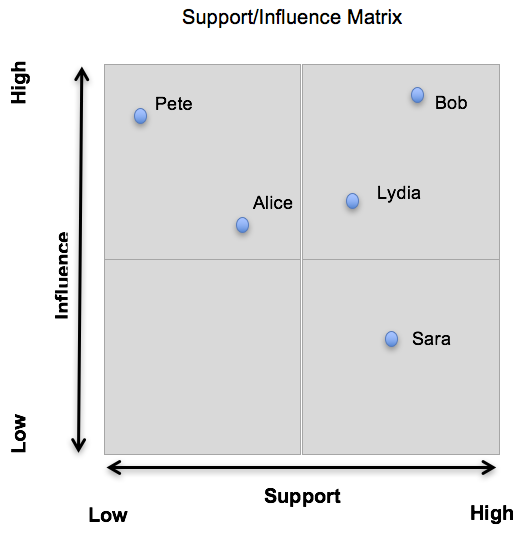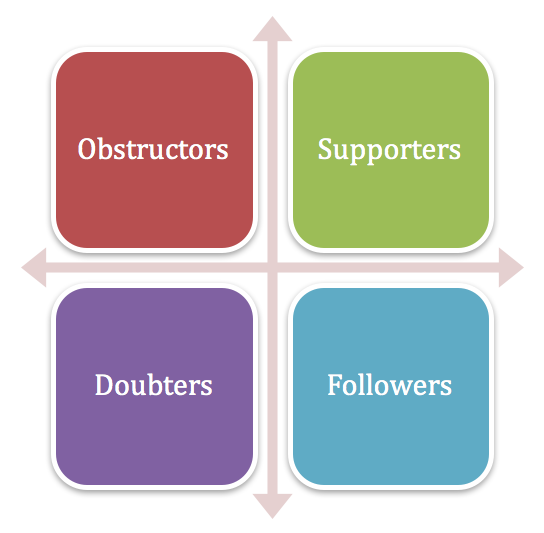As a project manager it’s important to know and understand who your stakeholders are and how to manage your relationships with them. People can make or break a project so handling your stakeholders well is essential.
At =mc we define stakeholders as: anyone who is involved or affected by the success of your project. For some projects this is relatively straightforward. For other bigger, more complex projects you can face a potential minefield of relationships that you need to manage. This can be overwhelming.
We also love visuals to help us to gain clarity with our thinking, and so we use the Support/Influence Matrix to map the people part of projects. This really useful tool can help you as a project manager to understand how your stakeholders feel about your project and how much power and influence they hold over it. And, therefore, how you should allocate your time and energy in handling them.
To put together a Support/Influence Matrix you need to go through the following steps:
There are several techniques you can use to identify your stakeholders:
This should generate a whole list of people with a greater or lesser interest in your project. It’s now useful to prioritise your list according to who you think are your most important stakeholders.
Once you have your key stakeholders you need to map them on to a 2×2 matrix by how much influence they will have – they make decisions that affect the project. And how much they will support it – the extent to which they want the project to happen and have a vested interest in the outcome. Something like this:

If you don’t know where to plot your stakeholders then you need to find out more information. Here are some questions you need to answer:
Remember, influence isn’t necessarily based on a person’s internal or external hierarchical position. It’s about how much power a stakeholder has over the direction or success of your project:
Once you have mapped everyone on to the matrix, cluster your stakeholders into groups. This will help you understand how you can best manage these relationships:

| Supporters | Have high influence over your project and are supportive. Consider how you could use this support |
| Followers | Don’t have a lot of influence over your project, but they are supportive. It is important you keep them on board. |
| Doubters | Don’t have so much influence over your project, but they don’t really support it either. It is important that you don’t ignore them as they could end up spreading their doubt. |
| Obstructers | Have high influence over your project but they don’t really support it. You will need to manage the relationship with these stakeholders carefully as they have the power to throw spanners into the works. |
By mapping people into these different clusters you can decide how and where to prioritise your efforts. Determine what steps and actions you need to take to make the most of those in favour of – and actively progressing – your project, and minimise the impact of those who would prefer it didn’t happen. See our top tips on this below:
This highly influential group can make or break your project through their active support. Make sure you keep them informed through personal communication, and invite them to key meetings and events. They can also be highly effective in advocates for your project, but don’t let them get too carried away with their enthusiasm! You can do this by making sure they are clear on the project objectives and the messages you want communicated. This person may be better placed than you to influence another stakeholder.
Looking at the example matrix above we can work out where we can get help with our greatest Obstructer, Pete. As Head of Finance, Pete is not happy about the costs and is actively seeking to cut the budget. On the other hand, Bob, Head of Operations and our strongest Supporter, understands the long-term return in investment the project will bring. And we know that Pete and Bob have a good working relationship. In this instance Bob is likely to be able to influence Pete to sign off the budget. Don’t forget to thank him for his enthusiasm and efforts.
While on an individual level your followers may not have much influence over your project, they are still an important resource that you can draw on to help you deliver specific activities. Think about ways in which you can grow their influence, such as banding your followers together en masse. For example, large campaign groups such as The London Cycling Campaign are extremely influential when it comes to decisions taken by TfL on cycling. As individuals they are unlikely to have the same sway. While you will be keeping this group up-to-date on your project it will likely be in a very different way to your Supporters. You can communicate with them through social media, newsletters, group emails, and open forum discussions. Again don’t forget to show your appreciation for their support.
As a busy project manager, this is the group you should spend the least amount of time focusing on. They aren’t helping you and they don’t have much impact on your project. Keep them informed through social media and open forum discussions, but don’t get dragged into long drawn out debates – something that easily done on platforms such as Facebook and Twitter. But do keep an eye of this group as you need to make sure they aren’t increasing their influence – either through growing in number, or through them actively seeking to influence your Followers and Supporters.
This is a key group to identify early on and build relationships with. While it may be tempting to avoid them, listen to what your Obstructers are telling you about their doubts and concerns – they may have legitimate worries. This is especially helpful when they can back up their concerns with evidence from previous projects they have worked on or come across before. Talk them through the benefits of your project and how the objectives and outcomes were decided. Your Obstructers can be a useful sounding board, highlighting gaps in your project thinking. Also consider who’s best placed to influence your Obstructers. There may be others who can help you.
Once you’ve planned how to manage these relationships it’s time to take action. As your project progresses your stakeholders will move around the matrix. Through actively reviewing and updating it, you can quickly adapt and respond to your stakeholders to ensure you are managing your relationship with them to gain their support and/or influence in a positive way.
If you are interested in finding out more about this tool and a range of other techniques to help you as a project manager, visit our Project Management training page. Or contact us about our in-house training and consultancy services on project management.